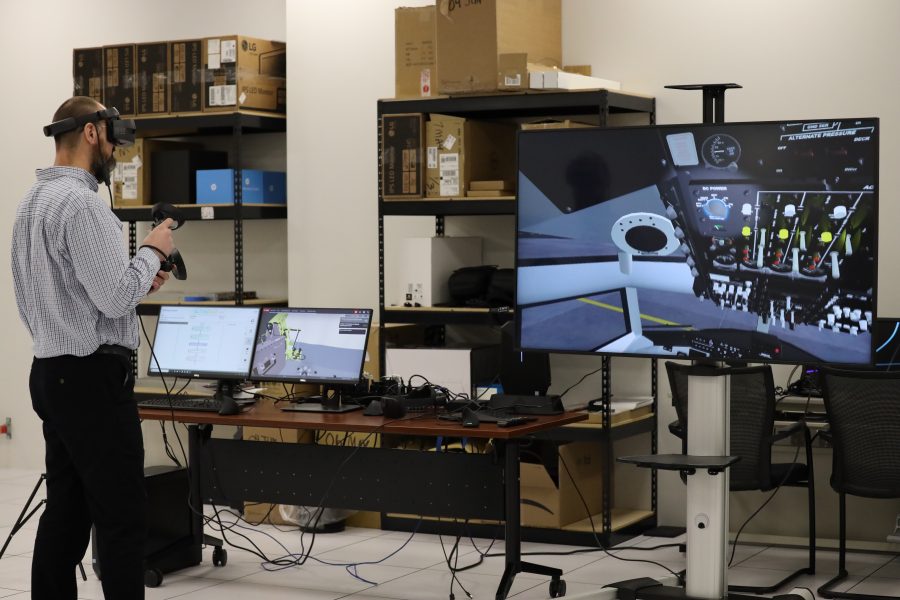TINKER AIR FORCE BASE, Okla.—Just a few hallways removed from the massive industrial floor of Building 9001, where technicians, welders and mechanics grind away to keep Air Force planes flying, a highy skilled team is solving crucial problems without bending metal, changing fluids, or fiddling with wires.
The Air Force Sustainment Center Software Directorate, barely one year old, was established in summer 2023 to unite three software engineering groups, a total of 5,000 engineers spread among a dozen locations. Their work here is a sign that the Air Force’s coding efforts have grown since USAF stood up its first software factory less than a decade ago.
As part of the Sustainment Center, the Software Directorate is among the Air Force’s largest software-focused organizations, yet typically flies under the radar.
“We’re creating software all the time,” Michael E. Jennings, senior leader for the directorate, told Air & Space Forces Magazine. “We’re not called the Software Sustainment Directorate. We are the Software Directorate within the Sustainment Center. And so our mission really is probably much bigger than a lot of people realize.”
Jennings and his engineers focus on the future, trying to see what new advances and improvements they can program into software to enhance aircraft performance.
“We are constantly very aware of what the threat is from our adversaries … being able to create software very quickly in a DevSecOps environment, to be able to take software and put software on a platform very, very quickly, to be able to handle whatever threat is out there,” Jennings said.
The team’s involvement in a weapons system depends on who owns the data rights. The Software Directorate is almost entirely responsible for the software on the F-16 and A-10, for example, while providing supplementary code for the F-35, Jennings said.
Older aircraft like the B-52 or E-3 are also getting updates. “You absolutely have strong software systems that can be put on a lot of these systems,” so as long as they can keep flying.
Integrated
But even more than platform-specific code, software that is applicable across platforms and enables better technical integration is where Jennings focuses his team.
“We’re not winning against our adversaries with one single airplane anymore,” Jennings said. “We’re winning it as an integrated system. And the way it’s an integrated system is through software. It’s that software that’s talking to all of these systems, whether it’s an up-front F-35 using its sensor systems to understand what the battlefield looks like and connect that with an F-22 and to be able to connect that back to a B-52 to be able to engage weapons.”
What that looks like is a common, government-owned standard interface, through which any aircraft system can exchange data. Such Open Mission Systems have been a holy grail for years for program executives.
Jennings’ crew works with the Air Force Life Cycle Management Center and Air Force Materiel Command’s new Integrated Development Office to prioritize work. Together, they share recommendations, priorities, and then take action, depending on whether the aircraft’s software work is led by the directorate or industry.
“As we talk about the systems of systems, we’re really laying out that framework for how we connect together and really create the next generation of the standard architectures for how we interconnect together,” Jennings said.
Now the Air Force is pushing to modernize battle management and command, control, and communications—the systems acquired and developed for that effort need to be able to work together to transfer data at the speed the service needs, and common software can help that. To that end, Jennings said his team regularly works with C3/BM czar Brig. Gen. Luke Cropsey to ensure they are on the same page.
Federated
“We need to be able to be better and design more what I call federated systems, in regards to how the systems are set up to be able to make rapid changes to mission computing while leaving the flight stuff, alone,” he said.
Changing software code in one area can impact other parts of the code, affecting flight safety, so changes must be rigorously examined and tested—slowing the pace of upgrades. In the future, Jennings wants the software controlling different functions within the aircraft to be more separate and distinct, so that an update to one will not affect other aspects.
“It’s like Legos, right? It’s creating a system of Legos,” Jennings said. “Some Legos, you’re leaving alone. You’re leaving those structures apart, but you’re allowing these systems to be able to talk to each other and integrate each other to be able to function and to understand where each other are at. Making sure we have the right radios on the systems to be able to communicate, to be able to pass data, to each other, and to be able to trust that data is so important.”
How Fast Can They Go?
Federating systems within aircraft should accelerate updates. Already, speed is improving, even if it’s not as fast as many would like.
“Most of the changes we’re measuring on the F-16 are now in months and not years,” Jennings said. In future systems, updates could be much faster. But in older ones, the limitations on speed remain.
“When you talk about DevSecOps in its purest form, you’re pushing stuff out there, like, on a daily basis,” Jennings said. “You can’t do that with a B-52 because of the way it’s architected, but I can still create changes to that.” It’s all just a matter of time.


